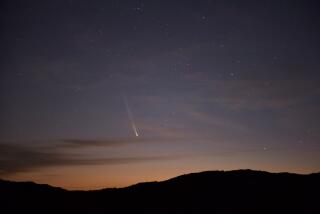Nights of the Comet Nearing a Zenith for Watchers
- Share via
High in the Angeles National Forest beneath a dome of fresh night sky, the watchers congregated.
There was a kind of reverence to what they did, pulling into the small clearing off Old Ridge Route with headlights switched off so as not to profane the dark; talking low as they set up their paraphernalia; quieting their children and urging them to look, look.
In the lower left of the sky, 123 million miles away, shone the small, bright smear of comet Hale-Bopp dropping imperceptibly toward the horizon.
“This comet is beautiful and incredible,” said Leah Shirokoff, a watcher who’d driven to the clearing from her home in Kagel Canyon and joined two dozen others Thursday on the dark hillside. “The last one, Hyakutake, we hardly saw. Not impressive at all. This one, it’s what you’d think a comet would look like.”
For more than a week, Hale-Bopp has been building toward maximum visibility in the early evening sky, manifesting itself to the naked human eye, even in the light-polluted city of Los Angeles.
On the few clear nights during this period, it has appeared in the windshields of enchanted homebound freeway commuters, and nestled obligingly into telescopes set up on the front lawn of Griffith Observatory, attracting about 10,000 visitors for free comet-viewing. So watcher-friendly has it been that the owners of optics shops were recommending people use low-power binoculars so their view of the comet would be wide enough to include its tail.
The comet’s curriculum vitae was impressive: Born in deep space of the ur-matter of the universe--of primeval dust and ice and gases. Tumbling through the vacuum at nearly 93,000 mph and dragging a tail of vapor 25 million miles long. Not seen by earthlings for 4,200 years. Not to be seen again for 2,400 years.
*
Not all who have watched it, however, confined themselves to such scientifically ascertainable aspects. The comet helped prompt 39 members of a delusionary cult, convinced it was accompanied by a spacecraft that would transport them to a higher level of existence, to quit their earthly lives.
And yet, stately and remote in the northwestern sky, the comet was hardly a breathtaking sight. Clearly, the spell it cast had to do with something beyond entertainment value.
In the clearing off Old Ridge Route, Charles “Butch” Sahutske, a prototype machining consultant from Sun Valley, stood in the chill breeze pondering the comet and his own existence.
*
“It’s just mind-boggling how far away it is, and how insignificant you feel when you look at the whole picture,” said Sahutske, who’d come to watch with his wife Maria and 12-year-old daughter, Sarah.
He shook his head as if to clear it of wonder. “The age of it,” he continued. “The fact that we’re looking at the light of stars that’s traveled millions of years, and whatever we’re viewing now is ancient, ancient history. It’s just mind-boggling, the time factor.”
To many in the clearing, the comet was an oddly comforting reminder of the vastness of the universe.
“In the course of ordinary life,” said watcher Joe Glaser, a psychologist from North Hollywood, “it’s all, ‘Is there a sale on at the mall?’ ‘Is my car going to make it to the next tuneup?’ ‘Am I going to get enough work this week?’ ‘Am I going to get laid off in a year?’ Those are the things that most of us think about. This puts everything in perspective.”
The watchers were dismayed and sometimes darkly humorous about what Glaser called the “sad, tragic and sick” suicides of the 39 members of the Heaven’s Gate cult in Rancho Santa Fe. The cultists believed the comet heralded their salvation.
*
“It’s just so sad, those people killing themselves because of this,” said George Willis, a video post-production specialist from Burbank, as he adjusted his 8-inch Meade telescope. “It’s a huge pointer to the fact that we really need to educate people, not necessarily in astronomy, but just in general.”
But perhaps the most compelling conviction traded among the watchers was that people have a natural affinity with the comet. The comet was made up of the same gaseous materials that were the building blocks of all life, including human life.
Gazing 123 million miles into the distance, they believed they were getting a better view of themselves.
“Of course, we’re all stardust. Every human,” mused Carson librarian Bob Alborzian, shivering in a light jacket. “I just hope I’m not part of a forgotten star, you know?”
More to Read
Sign up for Essential California
The most important California stories and recommendations in your inbox every morning.
You may occasionally receive promotional content from the Los Angeles Times.













